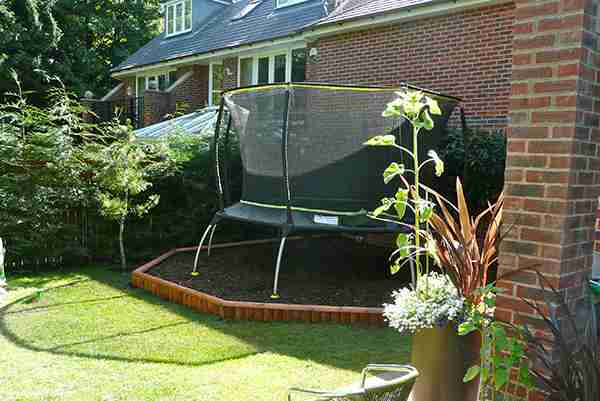
Best Backyard Trampoline for a Small Yard
Choosing the Best Backyard Trampoline

Trampolines are an endless source of entertainment, especially today when most entertainment is electronic. However, not everyone can enjoy a trampoline because a lot of backyards are just too small to contain them. Should this mean that a potential user ought to give up on owning one? Of course not. It only means that they have to find the best backyard trampoline that would fit in their small yard. Luckily, there are a lot of trampolines for small spaces out there.
Best Size Trampoline for a Small Backyard
Let’s first talk shape. In case of small yards, a circular or octagonal trampoline can work well. However, if a user also happens to have a narrow yard, then it’s best to go rectangular.
In terms of height, a 12 ft. trampoline works wonders for anyone. It’s not too tall, yet it offers enough protection for anyone bouncing inside. Of course, anything below this height also works, but those trampolines are usually too small for adults. They are appropriate for kids, however.
Trampoline Ideas for a Small Garden

Aside from size, there are a few elements anyone with a small garden ought to consider. First, there’s the shape. If possible, the best thing to do is to get a trampoline that won’t damage or disturb a garden. Rectangular and square trampolines work like a charm here. However, one mustn’t forget safety. Whenever possible, we should choose a trampoline with an enclosure. After all, bouncing off of the surface and landing face-down in the grass or flower patch is dangerous both for the jumper and the garden.
General Trampoline Ideas
Whenever someone wants to choose the best backyard trampoline, they ought to think about several other elements aside from size and shape.
Money
First of all, let’s talk price. On one hand, buying an overpriced trampoline can do more harm than good. It’s never a perfect idea to overpay for a trampoline. This means that customers ought to do their primary research on the product that interests them. On the other hand, overly cheap trampolines can be dangerous. Maybe there’s something wrong with it, or the quality is poor. And a poorly put-together trampoline can actually hurt the jumper. Staying in the middle is the best option, and researching the price beforehand can give the potential buyer enough of an idea on what to do.
Branding
There is a good reason for top brands selling as well as they do. In every industry, a known brand has more of a chance of being good than an unknown brand. A random trampoline made in a random Malaysian basement MIGHT perform well, sure. However, it’s more likely that it will malfunction, unlike an established brand. They are more likely to be working properly.
Of course, there’s always the issue of blindness to other brands. Trampoline manufacturers vary in quality, but sometimes even the quality of different models within a single brand can turn a potential buyer off. Again, research is vital, and doing proper, objective research on a single model can save the shopper both time and money, as well as keep their safety.
“Ratings”
This works in conjunction with the last idea, with some minor differences. Once again, a shopper ought to do research, but instead of going brand by brand, they go model by model. More specifically, they take a good, long look at the user reviews.
Sometimes that Panasonic product can be god-awful. Other times, that random Chinese-named advice can have the most glowing reviews. And we’re talking actual reviews, not bots or paid reviews. The only real way of knowing this is to research the topic thoroughly. We need to take a look at, for example, the top twenty or so trampolines. Then we can see the best one that can fit our small yard.
Accessories
This isn’t really necessary, especially for smaller yards. But if a user wants to add some lights or covers, for example, then he or she ought to find out which accessories go with their soon-to-be trampoline. Accessories make the jumping even more fun, especially for the kids. Therefore, getting a trampoline with an additional device or two will always help.
Alternatively, if a shopper doesn’t have the money for accessories, they can always look up WHICH trampolines allow for further adjustments. They can always buy the desired extras later.
Picking the Best Trampoline for a Small Yard
Now that we know the basic “rules” of buying a trampoline for a small backyard, we can provide our three picks. Each trampoline presents a single rule, which is why they were chosen in the first place.
The Best Price: 7-Feet Round Propel Trampoline
Propel does good work when it comes to building trampolines. Let’s take the 7-feet round model, for example. First of all, it’s nice and round. While there’s nothing wrong with square or rectangular trampolines, the round ones count as “classics.” There’s just something so attractive about a round trampoline nowadays.
But it isn’t just the shape. The whole trampoline is 7 feet round and 86 inches tall. In addition, it comes with an enclosure, a yellow and black safety pad, and a free Jump-n-Jam hoop system. This is in case your kids want to play “trampoline basketball.”
So, we have an enclosure, a sturdy, short trampoline, AND accessories. How much could all of this possibly cost? The answer is – a little under $150. Check the current price on Amazon. If anything, it’s a steal to get this Propel model at such a low price. And yet, it doesn’t sacrifice safety, nor attractiveness. Read more >>
Some Propel Trampoline Setbacks
A few people complained about the size, including those with small yards. After all, a 7-foot width isn’t exactly big enough for more people to bounce on. But the somewhat bigger issue is that the enclosure might mess with the user. It can sometimes only connect to four or so spots, forming an open cube of sorts. This both limits the space for jumping and cuts off perfectly jumpable areas of the trampoline. It’s without a doubt something that requires fixing.
The Best Brand: Zupapa Trampoline
The Zupapa is a relative newcomer to the trampoline business. However, they have proven to be quite popular with the shoppers. One of the models that stood out lately is the 2018 round trampoline.
This particular model comes in three different diameter sizes. For anyone with a small backyard, a 12 ft. diameter Zupapa trampoline will do great. Not only is this model round, but it also comes with an enclosure, a rain cover, a ladder, some wind stakes, and a spring pulling tool.
Most people who bought this trampoline had nothing but high praise for it. The frame is durable enough to withstand even the most active bouncers, and the simple design makes it fit well with any yard. Both the mat and the pad last for a while before any real damage occurs. On top of that, the trampoline is really easy to assemble. Users report a total of three hours required to put the whole trampoline together.
Small, durable, attractive and fun – sounds like a bargain! Check the current price on Amazon.
Some Zupapa Trampoline Setbacks
Naturally, even Zupapa models have their flaws. The somewhat high price might be one of them, but compared to other, lower-quality models on the market, it’s not that much of a problem.
The bigger issues come with the trampoline elements themselves. Quite a few users reported that the enclosure would be damaged after a few months. Oftentimes the mat itself would tear, and replacing the mat, or any other parts, isn’t really cost-effective with Zupapa trampolines. And speaking of parts, there were even a few reports of trampolines arriving with some parts missing. All of these are valid reasons to skip Zupapa and focus on other trampolines. Read more
The Best Model: 8 ft. Compact Springfree Round Trampoline

Springfree is a beast in and of itself. The whole idea behind this manufacturer was to produce trampolines that don’t use springs and that eliminate risks caused by traditional trampolines. Springfree designers opted to use sturdy plastic rods that bend with each bounce instead of traditional springs. Everything else about the trampoline is made of basic materials, such as plastic, rubber, etc.
These trampolines have proven to be bouncier than those with springs. But the question is whether there’s a model for a small backyard. The answer is a resounding “yes,” with the smallest trampoline having a diameter of 8 ft. A perfect fit for the kids!
Speaking of kids, this trampoline also comes with a basketball hoop, as well as an interactive game called Tgoma. The children will have hours of fun either shooting hoops or exercise within a “smart trampoline.” Check price here >>
But the Springfree round trampoline is not just fun and attractive-looking. It’s also extremely durable. Numerous reports state that the trampolines endured over half a decade before anything had to be replaced. That’s quite a long “shelf life” for a product like this.
Some Springfree Round Trampoline Setbacks
Even Springfree isn’t “flaw-proof.” Most unsatisfied users claim issues such as zippers on the enclosure breaking off, plastic rods coming off, and assembly being very difficult. Then there’s the price. To some, $2000 might be steep for a trampoline. This is especially problematic when we understand that there are cheaper models on the market. Check the latest price on Amazon.
So Which Trampoline Should Be In Your Backyard?

It’s difficult to say what the best trampoline for a small yard is. Any of the three models noted above can fit the bill. Some are cheaper, some more durable, and some offer more bounciness. However, what they all have in common is their size. All three can fit neatly in any small backyard, and they won’t crowd or feel out of place.
If a user doesn’t mind the price, either Zupapa or Springfree will suit his or her needs. However, if they happen to have a tighter budget, Propel is the way to go. Propel and Zupapa are also great choices if we aim for something more familiar, i.e. spring trampolines. They are easier to repair and we can find replacement parts more easily. Design-wise, however, Springfree trumps them easily.
Whatever the choice, one thing’s for sure. Any small backyard will benefit greatly from these trampolines, and they will entertain us for hours on end.
Looking for a trampoline? Don't buy something you'll hate
Here is a list of our buying guides to help you find the best for your needs:



